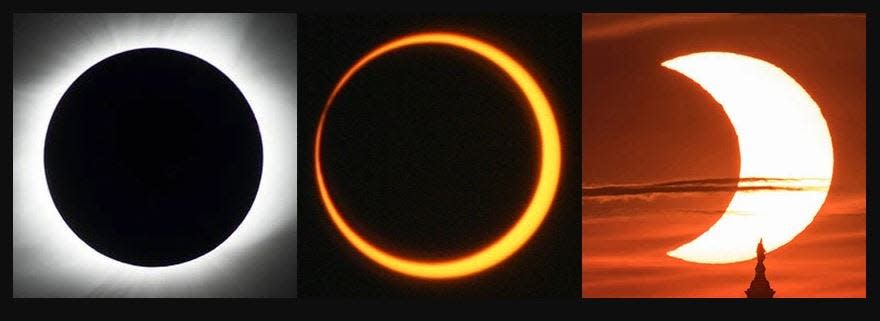Rare annular solar eclipse will be visible from southern Utah. When and how to view
The next “annular” solar eclipse, known as the "ring of fire", will be visible across much of the U.S., including Utah, on Oct. 14.
Known as the "ring of fire" thanks to shape of circular light created by the partial eclipse, the event is expected to occur this Saturday, Oct. 14, and travel from the coast of Oregon to the Texas Gulf Coast, according to NASA.
The path of the eclipse will move directly through Utah, from the northwest to the southeast, and with clear weather expected, astronomers say it could be among the best places for viewers.
In and around Richfield, in central Utah, astronomers from around the world are expected to visit and view the eclipse, with the Utah Department of Transportation issuing traffic warnings about unusually busy roads in the usually little-traveled central parts of the state.
Snow College is hosting a festival for the eclipse at its Richfield campus, with free viewing for visitors.
When is the 'ring of fire' solar eclipse?
The solar eclipse will begin on Saturday and, weather permitting, first become visible in Oregon around 9:13 a.m. PDT and end in Texas around 12:03 p.m. CDT, according to NASA.
It will then move beyond the U.S. and over Mexico, Central America and finally South America before ending around sunset off of Natal, Brazil in the Atlantic Ocean.
Not all eclipses are the same. An annual solar eclipse is when the moon passes between the sun and Earth while it is at its farthest point from Earth, according to NASA. The moon appears smaller than the sun during this rare event because it’s further away from Earth than typical.
This will be the last annular solar eclipse that will be visible from the U.S. until 2039. A total solar eclipse will occur early next year as well. On April 8, 2024, a total solar eclipse will cross North America, passing over Mexico, the United States and Canada, NASA said. Next year's eclipse is the last total solar eclipse that will be visible in the U.S. until 2044.
What's an annular solar eclipse?

An annular solar eclipse occurs when the moon passes in between the sun and the Earth while at its farthest point from Earth.
The shadow of the moon is made up of two cone-shaped parts, one of which is located inside the other.
What's the difference between a solar eclipse and a lunar eclipse?
There are two major types of eclipses – solar and lunar.
As the moon orbits the Earth, it sometimes moves directly between the sun and Earth. When this happens, the moon blocks the light of the sun from reaching Earth, NASA said. This causes an eclipse of the sun, or solar eclipse.
Dangers of looking at the sun
It's never safe to view the sun with the naked eye. Without proper eye protection, you can suffer "eclipse blindness" – a serious injury in which the eye’s retina is damaged by solar radiation – within seconds of staring at the sun, according to the American Optometric Association.
Viewing a partial or annular solar eclipse could also expose your eyes to possibly harmful ultraviolet (UV) rays.
We can see parts of the electromagnetic spectrum, which is the visible light we see. The cornea, the eye's protective surface, can also be damaged by UVB rays, which cause pain and poor vision. UVA rays cause permanent blindness and lens damage in the eye, as well as damage to the macula and sensitive retina in the back of the eye.
Photokeratitis, often known as an eye sunburn, happens when ultraviolet rays harm the surface of the eyes. UV radiation exposure has the potential for irritation to the corneas of the eyes.
How to safely view a solar eclipse
During the eclipse, special eclipse glasses, or welder's goggles, must be worn. That's because the sun's surface is so bright that if you stare at any portion of it, no matter how small, it produces enough light to permanently damage your retina.
Our eyes never evolved to look at the sun without suffering severe damage. Regular sunglasses are also not safe to use.
Another tried-and-true method is creating your solar eclipse viewer.
Which eclipse glasses are safe?
If you buy eclipse glasses, be sure they are made by companies the American Astronomical Society and NASA have certified as safe for use. They should all have the "ISO" (International Organization for Standardization) icon. The glasses also must have the ISO reference number 12312-2.
A sampling of certified companies:
Contributing: USA TODAY.
This article originally appeared on St. George Spectrum & Daily News: Utah among best places to view rare annular solar eclipse

